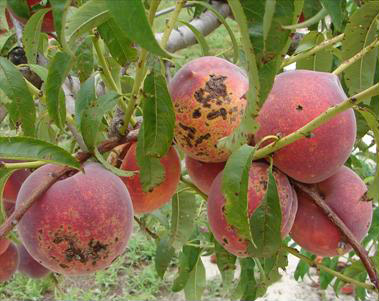Contents
Early disease management
2009 New England Tree Fruit Management Guide available
Mark your calendar
Last chance to chop
leaves
To improve scab control, chop your apple leaves now. We’ve spent some time formalizing this idea, and have a Fact Sheet that describes the process:
http://www.umass.edu/fruitadvisor/factsheets/f134.html
We recommend that all growers consider leaf chopping and/or urea applications to reduce scab.
Urea applications are best applied 3 or 4 weeks before bud break, so it’s getting late. But they’ll still be useful, just not as effective. And it might get cold again.
D. Cooley
Early season apple sprays
As usual at this time of year, it’s time to remind people that copper is a good idea. Primarily, a copper spray on apples is targeting fire blight. However, it will also do as much to protect against possible green tip scab infections as an early application of Dithane or Penncozeb. One school of thought suggests that it also gives an early season nutritional boost to developing buds, and may kill ice-nucleating bacteria! We’re not sure about those last two suggestions, but copper won’t hurt unless it’s applied too late, after green tip. We recommend it.
D. Cooley
Don't forget the peaches
There are two peach diseases that should get some attention while trees are in a late dormant stage – peach leaf curl and bacterial spot. Bacterial spot can be treated with a copper, and fortunately, so can leaf curl. So, the most efficient approach for these diseases at this time of year is a relatively dilute copper spray. It is important to get thorough coverage of the tissue, so that the solution will get into the cracks and crevices in the buds and bark tissue, where the fungus that causes leaf curl and the bacteria that cause bacterial spot have overwintered.
While most copper formulations are labeled for both diseases, check to make sure. Use a relatively high rate. For example, C-O-C-S should be applied at 5 lbs./acre, or Kocide 2000 at 7.1 lbs./acre.
If your peaches and nectarines haven’t had a bacterial spot problem, and you aren’t growing susceptible cultivars such as Autumnglo, Babygold 5, Redhaven, or the California sub-acid types, then you could still use copper for leaf curl. Or, you could use one of several other fungicides, including Bravo or other chlorothalonil products, Echo, Ferbam, Thiram or Ziram. Whatever is used, it has to get on before the buds break to be most effective.
D. Cooley
 leaf curl on peach |
 bacterial spot on peach |
FRIDAY, March 20, 2009
Apple
IPM: Saving Early Season Scab Sprays
2009 New England Tree Fruit Management Guide available
The 2009 New England Tree Fruit Management Guide is available for purchase here:
http://www.umass.edu/fruitadvisor/2009/2009netfmg.html
Mark your calendar
April 21, 22, 23, 2009: Tree fruit twilight meetings, 5:30 PM, locations TBA
July 15, 2009: Massachusetts Fruit Growers' Association Summer Meeting, Tougas Family Farm, Northboro, MA
December 15-17, 2009: New England Vegetable & Fruit Conference, Manchester, NH
